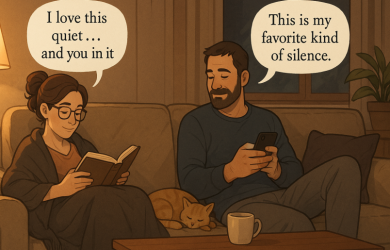What Is Demand Avoidance in Relationships? Signs & Solutions

Unlock Daily 30-Sec Tips for a Happier Relationship
👉 Subscribe FREEKey Takeaways
Marriage.com AI Quick Summary
You ask your partner, “Can you help me with this one thing?”—and suddenly, their mood shifts. They pause, look away, and say, “I don’t know… maybe later.” It feels small, but it happens a lot. You’re left wondering,
Did I ask too much? Did I say it wrong?
Sometimes, it’s not about what you said—but how it was received. When requests, even gentle ones, lead to withdrawal, tension, or defensiveness, it can feel confusing, even lonely.
This isn’t always distance or disinterest… sometimes, it’s something deeper. Something that doesn’t mean they don’t care. It might be demand avoidance showing up.
What is demand avoidance in a relationship?
Demand avoidance in a relationship happens when one partner reacts to requests—big or small—by withdrawing, shutting down, getting irritated, or avoiding follow-through. It’s not about being lazy or uncaring.
It’s a stress response triggered by feeling overwhelmed, anxious, or emotionally unsafe. Even simple questions like “Can we talk?” can feel like pressure. Instead of engaging, the person may instinctively resist or avoid to protect their sense of control or reduce discomfort.
-
Why does it happen: The root cause
One common association is demand avoidance autism, a profile often referred to as PDA (Pathological Demand Avoidance), where individuals on the autism spectrum may struggle with everyday demands due to high anxiety and a need for control.
Research shows that Pathological Demand Avoidance (PDA) is a common disorder seen in children on the autism spectrum who intensely avoid everyday demands. They might use distraction, control others, or have sudden mood changes.
However, this is not the only reason someone might experience demand avoidance. Many people without autism also display similar behaviors due to other factors like:
- Past trauma: People who’ve experienced emotional, physical, or relational trauma may feel easily overwhelmed by demands. Even small requests can trigger memories of control, fear, or helplessness.
- Emotionally neglectful or controlling upbringings: Growing up in homes where feelings were ignored—or where love was conditional on performance—can lead someone to resist anything that feels like pressure or obligation.
- Chronic burnout: When someone is emotionally or physically exhausted for long periods, their nervous system can become overly sensitive. They may avoid tasks simply because they feel drained or emotionally overloaded.
- Anxiety disorders: For some, anxiety turns everyday interactions into overwhelming experiences. The fear of getting it wrong, being judged, or disappointing others can make even minor requests feel paralyzing.
- Frequent criticism or rejection: Repeatedly being judged or put down can make a person hyper-aware of expectations. To avoid failure or shame, they might preemptively avoid situations that involve any kind of demand.
- Lack of respect for boundaries in the past: If someone has often felt that their “no” wasn’t accepted—or their needs were dismissed—they might start avoiding situations where they fear being pushed or cornered again.
5 signs that demand avoidance is affecting your relationship
When demand avoidance is present in a relationship, it can quietly shape how you and your partner interact. Over time, what might seem like simple miscommunications or emotional distance could actually be signs of something deeper. Recognizing these patterns can help you respond with more clarity and compassion.
1. They shut down when asked
Your partner becomes silent, withdrawn, or visibly anxious when you ask for something—whether it’s help with chores or talking about feelings. This isn’t about being cold; it’s a stress response where demands feel overwhelming.
- Example: You say, “Can we talk about our weekend plans?” and they quietly leave the room or go silent.
- How it affects: This leaves you feeling ignored and disconnected.
2. Small requests trigger big reactions
Even gentle or everyday requests can lead to frustration, sarcasm, or defensiveness. It’s not that your ask is unreasonable—it’s that the sense of being expected to comply feels threatening to them.
- Example: You ask, “Can you take out the trash?” and they reply with, “Why do I always have to do everything?”
- How it affects: This leads to misunderstandings and emotional conflict.
3. They avoid emotional conversations
Whenever you try to connect emotionally, they change the subject, make a joke, or say “not now.” Demand avoidance often makes vulnerable talks feel too intense or risky, even if love is present.
- Example: You express feeling disconnected, and they respond with, “You’re overthinking again,” or immediately shift the topic.
- How it affects: This creates unresolved tension and emotional distance.
4. Promises often go unkept
They agree to do things—like call you back, make plans, or help out—but frequently don’t follow through. This isn’t always intentional; avoidance and pressure can lead to freezing or forgetting.
- Example: They say, “I’ll call you tonight,” but then disappear, and when asked, they say they “just didn’t feel up to it.”
- How it affects: This causes frustration, as it can feel like they are always hesitating or indecisive.
5. You feel like you’re the only one trying
Over time, you may notice you’re doing most of the initiating—whether it’s for conversations, decisions, or emotional connection. This imbalance is common when demand avoidance makes one partner retreat from engagement.
- Example: You’re always the one bringing up issues, asking questions, or trying to reconnect—while they pull away or delay.
- How it affects: This creates a sense of loneliness or frustration, as the relationship feels one-sided.
7 solutions to deal with demand avoidance in relationships
Dealing with demand avoidance in a relationship can feel frustrating and emotionally exhausting—especially when it seems like even small requests lead to resistance, shutdowns, or defensiveness. But with the right approach, it’s possible to create a safer space for connection, understanding, and emotional growth.
These coping strategies are not about pushing harder or fixing your partner—they’re about working together with patience, empathy, and clear communication.
1. Focus on collaboration, not control
People who experience demand avoidance often feel overwhelmed when something feels forced or imposed—even unintentionally. Instead of framing things as demands, try approaching tasks or conversations as shared goals or mutual decisions.
Collaborative language can reduce pressure and help them feel more in control of their response. It’s not about walking on eggshells—it’s about adjusting how you connect so both of you feel respected.
- How to start: Instead of saying, “You need to do this,” try, “How can we make this work together?”
2. Be mindful of tone and timing
The way something is said—and when it’s said—can make a big difference. If your partner is tired, stressed, or emotionally flooded, even small requests can feel too much.
Try to notice the emotional climate before starting a conversation. A calm, non-confrontational tone helps reduce the sense of urgency that triggers demand avoidance.
- How to start: Choose moments when both of you are relaxed, and begin gently: “Can we talk about something when you have a moment?”
3. Offer choices instead of instructions
Giving your partner choices can help them feel more in control, which lowers the internal pressure they might associate with demands. This small shift can reduce resistance and open the door to more cooperation. When someone feels like they still have autonomy, they’re more likely to engage willingly.
- How to start: Say, “Would you rather do it now or later today?” instead of, “You have to do this now
4. Recognize emotional overwhelm as a signal
When your partner avoids, shuts down, or overreacts, it’s often not about you. It may be a sign that their nervous system is overwhelmed. Understanding this helps you take things less personally.
Instead of reacting with frustration, you can pause, give space, and come back to the topic with more care and calm.
- How to start: When avoidance shows up, step back and say, “It’s okay—we can talk when you’re ready. I’m here.”
The research paper explores how avoidant attachment affects couples. People with this pattern often seem distant but are really protecting themselves.
5. Create emotional safety
Trust and emotional safety are the foundation for coping with demand avoidance. When your partner feels emotionally safe, they’re less likely to interpret your requests as pressure.
Reassure them that your intention isn’t to control but to connect. Consistency, kindness, and clear boundaries help build this sense of safety over time.
- How to start: Use affirming statements like, “I’m not trying to push—I just want us to feel connected.”
6. Set gentle but clear boundaries
Supporting someone with demand avoidance doesn’t mean giving up your own needs. It’s important to set boundaries that protect your emotional well-being, too. This means being honest about what you need, without blame, while still allowing space for their process. Boundaries help both partners feel safe and respected.
- How to start: Say, “I understand this is hard for you, and I still need us to talk about it by tomorrow.”
7. Consider outside support
Sometimes, demand avoidance in a relationship goes beyond what you can handle alone. Therapy or counseling—whether individual or as a couple—can provide the tools and insight to navigate these patterns more effectively. A trained professional can help unpack the deeper roots of demand avoidance and guide healthier interactions.
- How to start: Suggest couples therapy as a team effort: “I think we could both benefit from talking to someone together.”
How to move forward with demand avoidance in a relationship
When demand avoidance is part of your relationship, it requires compassion, patience, and a shift in how you both approach emotional needs. It’s not about forcing change, but about growing together through understanding and gentle communication.
Here are a few ways to build a connection while honoring both your needs and theirs:
1. Accept that their behavior isn’t personal
It’s easy to feel hurt when your partner avoids talking or doing things you ask. But in many cases, demand avoidance stems from internal anxiety or past experiences—not from a lack of love. Try to separate the behavior from their intentions.
- Example: If they cancel a talk you planned, remind yourself: “This isn’t rejection—it’s their way of coping with stress right now.”
2. Rebuild trust through a low-pressure connection
Trust helps ease the fear of demands. Start with small, pressure-free moments that show your partner it’s safe to engage. Focus on shared activities, laughter, or quiet time that doesn’t ask much from either of you emotionally—but still fosters closeness.
- Example: Watch a favorite show together or go for a walk without bringing up big conversations.
3. Celebrate small steps forward
Progress might not look like full cooperation right away. But if your partner makes an effort—like staying in a conversation a bit longer or responding calmly—acknowledge it. Positive reinforcement helps reduce their sense of failure or overwhelm.
- Example: Say, “Thank you for talking this through with me. I know that wasn’t easy.”
4. Use “we” language instead of “you”
When you use collaborative language, it feels less like a demand and more like a shared journey. This helps reduce defensiveness and encourages teamwork.
- Example: Instead of, “You need to help me more,” try, “How can we make things feel more balanced?”
A study published by the American Psychological Association found that couples who try new and exciting activities together tend to feel more satisfied in their relationship.
5. Don’t ignore your own needs
Caring for a partner with demand avoidance doesn’t mean you should neglect your own emotional well-being. Speak up gently, express your limits, and seek your own sources of support when needed.
- Example: “I understand this is hard for you, but I also need space to express how I feel.”
Watch this TED Talk by Artūrs Miksons, a respected psychotherapist who shares a powerful message: emotions are in our DNA. And embracing and expressing emotions constructively is key to emotional well-being.
6. Know when to seek professional help
If demand avoidance is creating a major barrier in your relationship and you’re both feeling stuck, therapy can help unpack deeper patterns and build new strategies. Sometimes, a third-party perspective makes all the difference.
- Example: “Maybe we could try seeing someone together. It might help us feel more supported.”
To sum up
Demand avoidance in a relationship can feel like walking on eggshells, but it often comes from a place of emotional stress—not lack of love. Recognizing it as a nervous system response, rather than personal rejection, allows space for compassion and healthier communication.
With patience, boundaries, and a focus on emotional safety, couples can learn to reconnect without pressure or fear. Moving forward might take time, but even small changes in tone, timing, and understanding can make a big difference. Healing is possible—together, one step at a time.
 Tips
Tips
Write your tip or submit a video tip
All tips are reviewed before the publishing.
Share this article on
Want to have a happier, healthier marriage?
If you feel disconnected or frustrated about the state of your marriage but want to avoid separation and/or divorce, the marriage.com course meant for married couples is an excellent resource to help you overcome the most challenging aspects of being married.
Recent Articles
Related Quizzes
Unlock Daily 30-Sec Tips for a Happier, Healthier Relationship
👉 Subscribe FREE on YouTube We'd love your feedback!
We'd love your feedback!
 Expert Q&A
Expert Q&A
Ask your question related to this topic & get the support you deserve from experts.



















 Thanks for your feedback!
Thanks for your feedback!